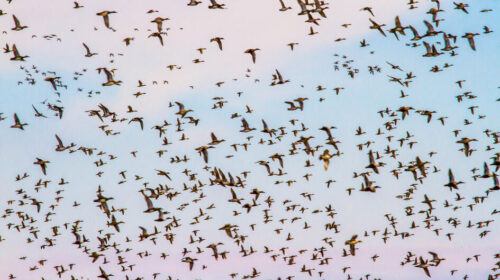When Logan Parker first sees a male, black-throated blue warbler near his Maine home each spring, two things strike him about the tiny bird. Its stunning appearance and the thousands of miles it traveled from its winter home in Central America or the Caribbean.
The birds have striking black masks and blue and white feathers. “They look so delicate,” said Parker, a birdwatcher and ecologist with the Maine Natural History Observatory. “It’s hard to imagine they make these long-distance movements to come here to raise young.”
For centuries, these birds and many others migrated long distances. They did so in tune with ancient spring rhythms, like the trees budding into many shades of green. But that’s changing.
Spring, known for its “pulse of food and life,” now arrives earlier due to warmer temperatures. Ellen Robertson, a co-author of a bird migration study, made this observation during her post-doctoral research at Oklahoma State University. The study highlighted a mismatch. It found that spring greenery appears earlier than some migratory birds arrive. This leaves birds like the black-throated blue warbler “out of sync.” For instance, they may reach their nesting sites after the peak insect emergence period.

22 September (Index Treasure) Robertson is one of many scientists studying migrating birds. They want to know if climate change will threaten the birds’ survival.
They are using a growing body of information. It offers the most complete picture in history of when, where, and how birds migrate. Recent studies have used 30 years of data from the nation’s radar network, satellite info, and citizen science projects. Mountains of long-term data are stacking up from bird watchers, bird banding stations, breeding bird surveys and more.
COLORADO:A remarkable migration captures the attention of scientists, reporter alike
The technological advances in radar, acoustic remote sensing and machine learning have been “incredible,” according to Andrew Farnsworth, a visiting scientist at Cornell University.
The ability to analyze, gather, and visualize enormous amounts of data are essential for making sense of patterns associated with the changing climate, Farnsworth said.
Warmer springs bring changes in bird migration
Spring’s arrival varies. It can be early or late. However, researchers say data shows warmer temperatures are arriving earlier, especially in northern areas.
This year, many parts of the U.S., especially in the Eastern half, saw spring temperatures 10 to 15 days sooner than the long-term average, said Scott Loss, a professor of natural resource ecology and management at Oklahoma State and one of Robertson’s four co-authors. The peak of the famed cherry tree blossoms in Washington, D.C., for instance, was the earliest on record.
Some birds left ‘out of sync’
Warming triggers some bird species to change their migration patterns and arrive in their spring breeding grounds days or weeks earlier than they used to.
Other species are less adaptable. They time their migration to length of day rather than temperatures, which means they migrate by the calendar, despite the warming world around them.
When flowers bloom, trees leaf out and insects emerge earlier than in the past, these birds miss out.
“You get to your breeding grounds and you didn’t arrive at the right time to have the big insect hatch that you need while you’re raising your fledglings,” said Melanie Smith, director of digital science and data products for the National Audubon Society.
Robertson and Loss were two of four co-authors on a study that looked at the migrations of 150 bird species along flyways from South America to the high Arctic, using remote sensing and satellite data to look at how bird migration coincided with spring green up.
The study, published in March in the Proceedings of the National Academy of Sciences, found migration and timing for some species were more closely related to the long-term average date for peak spring greening and leaf out rather than its current timing. That suggests the birds are stuck on calendar dates, Loss said.
Their study found reason to be “most worried” about long-distance migrants, like the black-throated blue warbler, Robertson said. Migratory journeys are “really costly” in terms of energy and calories for the species like the warbler that weighs only about a third of an ounce, the same as about two nickels.




